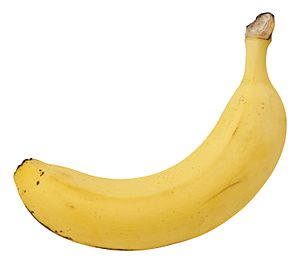Banana equivalent dose facts for kids
The Banana Equivalent Dose (BED) is a fun, unofficial way to talk about how much ionizing radiation you get exposed to. It helps compare radiation doses to the small amount you get from eating one average-sized banana. Bananas have natural radioactive stuff called potassium-40. This is one of the natural types of potassium.
One BED is usually thought to be about 0.1 micro-sieverts (μSv). But don't worry, this radiation doesn't build up in your body. Your body gets rid of extra potassium to stay balanced. The BED is just for learning, not a real scientific measurement.
Contents
History of the Idea
No one knows exactly when the idea of the Banana Equivalent Dose started. But it was mentioned in 1995 on a nuclear safety email list called RadSafe. A scientist named Gary Mansfield said it was "very useful" for explaining tiny amounts of radiation to people. He suggested that eating a 150-gram banana would give you about 0.1 micro-sieverts (μSv) of radiation.
How It's Used
The Banana Equivalent Dose is an informal measurement. This means any comparisons are just rough estimates. But some people find it helpful to show how different radiation risks compare.
The radiation you get from eating a banana is about 1% of the radiation you get every day. So, your average daily radiation is like 100 banana equivalent doses (BED).
Here are some comparisons:
- A nuclear power plant is allowed to leak a maximum of 2,500 BED (250 μSv) per year.
- A chest CT scan gives you about 70,000 BED (7 mSv).
- A very high dose of radiation that could be deadly is about 35,000,000 BED (3.5 Sv).
- People living 10 miles (16 km) from the Three Mile Island nuclear reactor during the 1979 accident received about 800 BED.
How the Dose is Figured Out
Where the Radioactivity Comes From
The main natural source of radioactivity in plants is potassium. A tiny part of natural potassium (0.0117%) is a type called potassium-40. This type of potassium slowly decays over a very long time. Because of this, natural potassium has a radioactivity of about 31 becquerels per gram (Bq/g). This means about 31 atoms decay every second in one gram of potassium.
A typical banana has about half a gram of potassium. So, it will have a radioactivity of about 15 Bq. Even though this amount is small, a truckload of bananas can set off alarms. These alarms are used at U.S. ports to check for smuggled nuclear materials.
The radiation dose from eating something is called the "committed effective dose." This is the total dose your body gets over 50 years from that radioactive material.
The US Environmental Protection Agency (EPA) says that pure potassium-40 gives a dose of 5.02 nano-sieverts (nSv) over 50 years for every becquerel you eat. Using this, one banana equivalent dose is about 78 nSv, or 0.078 μSv. This is often rounded up to 0.1 μSv in informal talks.
Why It's Not Perfect
Some experts say the banana equivalent dose isn't a perfect idea. This is because eating a banana doesn't really increase the radioactive potassium in your body for long.
The amount of potassium (and potassium-40) in your body stays pretty much the same. This is because your body has a system called homeostasis that keeps things balanced. If you eat extra potassium from a banana, your body quickly gets rid of an equal amount.
So, the extra radiation from eating a banana only lasts a few hours. This is the time it takes for your kidneys to bring your body's potassium back to normal. The EPA's calculation, however, assumes the potassium stays in your body for about 30 days. If the time it stays in your body is shorter, the estimated dose from the banana would also be smaller.
For comparison, a 70 kg adult has about 175 grams of potassium in their body. This natural potassium constantly creates about 5400 Bq of radioactive decays throughout their life.
Radiation from Other Household Items
Other foods that have a lot of potassium (and potassium-40) include:
Brazil nuts are special. Besides potassium-40, they can also have a lot of radium. This has been measured at up to 444 Bq/kg.
Tobacco has tiny amounts of thorium, polonium, and uranium. When tobacco is dried and smoked, these radioactive materials become more concentrated.
See also
 In Spanish: Dosis equivalente a una banana para niños
In Spanish: Dosis equivalente a una banana para niños



